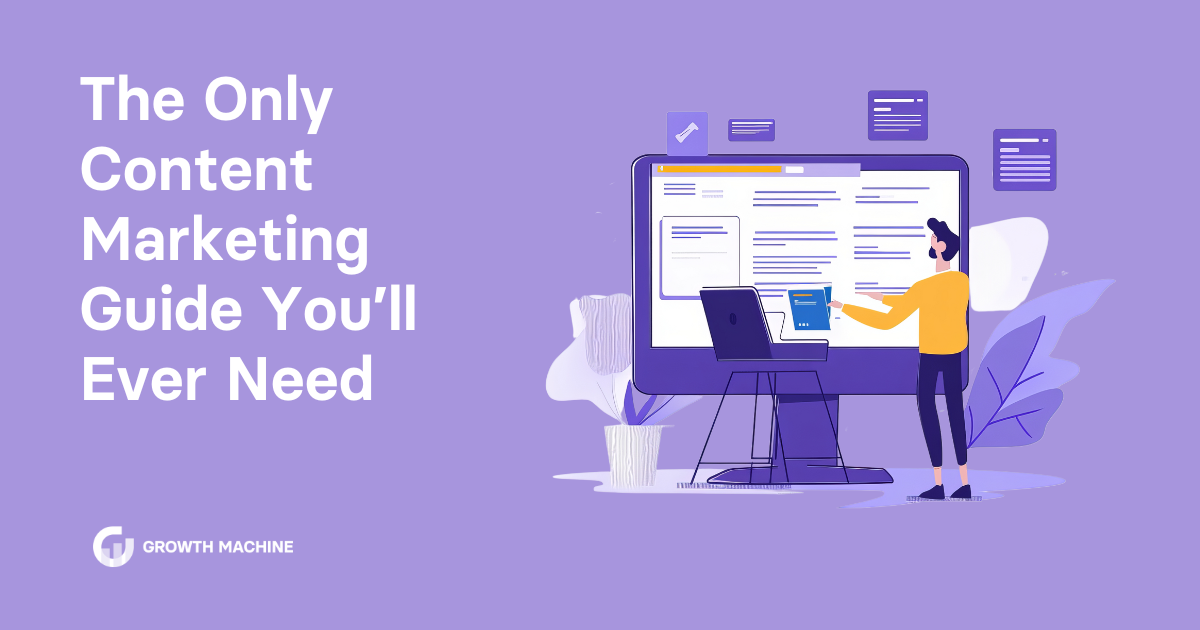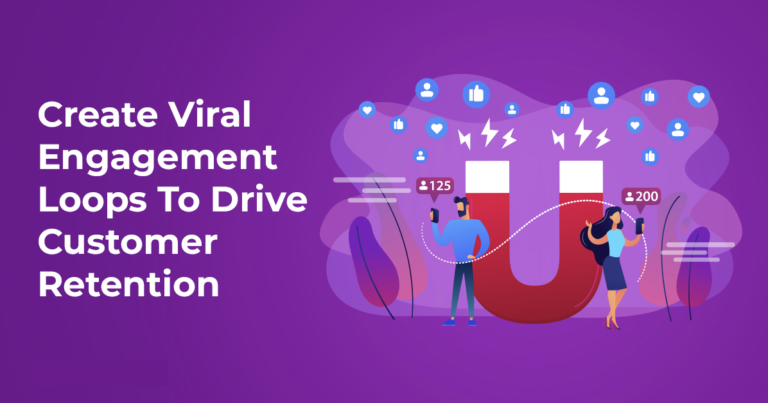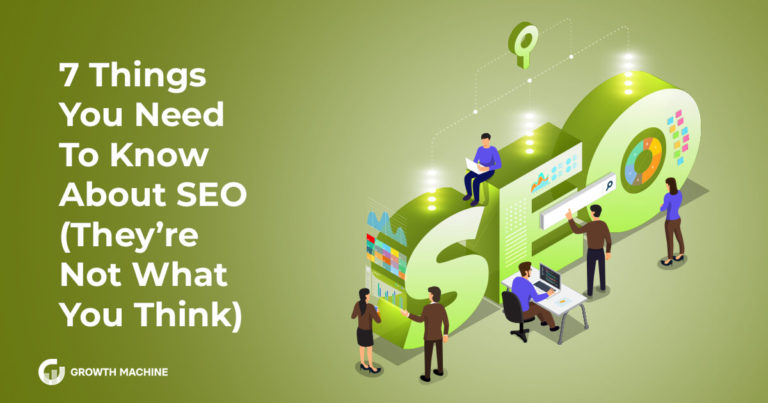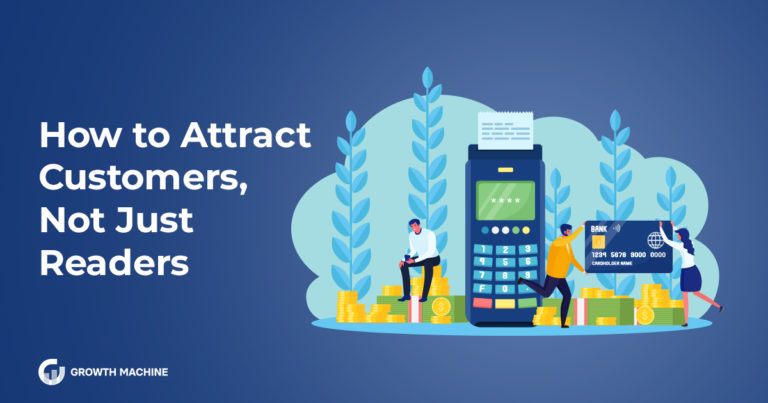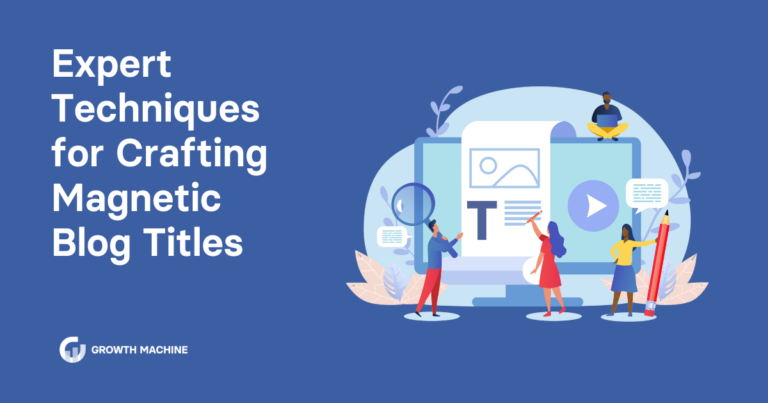The Only Content Marketing Guide You’ll Ever Need
Content marketing: Everyone’s talking about it, and many of us have tried it — but not always successfully. You have a solid brand and marketing resources, so why isn’t your audience biting?
We can help.
In this content marketing guide, we’ll break down why content marketing is (still) so valuable and share our seven not-so-secret ingredients for creating the best content that boosts engagement.
What Is Content Marketing?
Content marketing is a digital marketing strategy where businesses create valuable content and share it with their target audience. It’s a refreshing departure from traditional marketing, where businesses push products or services without establishing any kind of relationship with shoppers first.
Instead, content marketing works by delivering high-quality content that resonates with potential customers’ pain points. It’s more of a long-term approach, but it helps businesses build trust and foster long-term relationships that can ultimately lead to more sales. Since 53% of shoppers do research before they buy anything, content marketing is an essential strategy for overcoming shopper skepticism.
Most people think of blogging when they think of content marketing, but it’s so much more than that. Several components make up content marketing, including:
- Content creation: Successful content marketing considers your target audience’s pain points and creates content that offers a solution. This content can take just about any form, whether that’s a blog, infographic, podcast, or social media post.
- Optimization: Search engine optimization (SEO) is its own discipline, but you can’t have compelling content marketing without it. With SEO, you tweak certain aspects of your content to stand out better on search engine results pages (SERPs). Ultimately, the goal is to rank as closely to the top of the SERP as possible to boost your chances of being found by your target audience.
- Distribution: Writing content is just one piece of the puzzle. You can write the world’s greatest blog, and it may just sit there, unread, without a solid distribution strategy. This stage of content marketing requires putting your content in front of your target audience. That means sharing content across social media platforms, email, or your website so it reaches the right people at the right time.
- Assessment: Your job isn’t over once someone reads your content. At this stage of content marketing, you monitor your metrics with tools like Google Analytics. That will tell you which content brings the most traffic and engagement to your site. You’ll also learn which topics, formats, and posting times work best for your audience.
Benefits of a Successful Content Marketing Strategy
Content marketing isn’t a get-rich-quick scheme. Both potential customers and search engines prefer a slow burn that steadily builds over time.
Instead of coming in hot with demands like “Buy Now,” you offer loads of helpful information that makes you a trusted confidante. Over time, that trust will steadily convert into sales and customer loyalty.
Done well, content marketing benefits your business in so many ways, including:
- Making progress on your business goals: Every business has goals. A solid content marketing strategy ties directly into your business goals, whether you want to boost sales or increase customer retention. If you’re struggling to cross the finish line, effective content marketing might be the nudge you need to get results.
- Building brand awareness and trust: Your audience can’t become customers if they aren’t aware of your brand. It won’t happen overnight, but consistently creating high-quality content will make your brand more visible. The more potential customers see and interact with your content, the more they’ll trust your business as a reliable source of information — and that’s worth its weight in gold.
- Lead generation: Need leads? Content marketing is one of the best ways to generate leads. Content gives you the perfect avenue to gather leads’ contact information in exchange for high-quality content. Your marketing crew will need to nurture these leads after the fact, but a solid follow-up content marketing campaign is sure to boost engagement and, eventually, sales.
- Establishing authority: Authority isn’t an easy thing to come by in an age of crowded inboxes and misinformation. However, consistently creating actionable, solution-focused content will position you as a trusted thought leader. Over time, that leads to more podcast interviews, speaking gigs, sales, and other fun benefits of being a trusted voice in your industry.
- Improved SEO rankings: Does it feel like Google is ignoring you? Regularly creating high-quality content optimized for SEO can improve your search engine rankings. Nearly 70% of all online experiences start with a search engine, so any improvement to your search visibility is a win.
Who doesn’t want more authority, sales, and engagement? These benefits are too juicy to pass up, so if you ever feel like giving up during your content marketing journey, remember what’s at stake.
If you’re feeling burnt out, consider outsourcing the heavy lifting. Growth Machine’s expert marketing team handles all content marketing strategy for you, from blogs to white papers and social media content. It’s like tapping the “easy button” to get marketing results without the hands-on effort.
Types of Content Marketing
Content marketing comes in all kinds of forms and flavors, although the biggest differences are B2B (business-to-business) versus B2C (business-to-consumer) content marketing. Each type caters to a different audience, so your business model will have a tremendous impact on your content marketing strategy.
B2B marketers establish thought leadership through more formal, professional content. B2B content positions you as the go-to pro for solving sticky problems for other businesses.
Since it takes ages for businesses to make a purchase, content marketing keeps you top of mind with your target audience. Content like case studies, in-depth white papers, and webinars are great for building trust with stakeholders.
B2C content is different — think of it as B2B’s more colorful cousin. This content targets everyday consumers. Interactive content and emotional stories are par for the course.
The goal is to connect with shoppers on a more immediate, personal level. Buying cycles are much shorter in B2C, but the price tag is also much lower than B2B, so volume matters. Content marketing examples in the B2C sphere include social media posts, infographics, video content, and email marketing.
7 Steps to Execute a Successful Content Strategy
Content marketing requires a little elbow grease, but you’ve got what it takes to get results. Follow this seven-step content marketing guide to write content that turns more heads.
1. Define Your Target Audience
Who you’re speaking to has a tremendous impact on brand voice, content topics, distribution, and so much more. You need to know your target audience inside and out, which means creating buyer personas.
These are fictitious representations of your ideal customers that highlight pain points, demographics, preferences, and needs. Your marketing team refers to these personas every time they sit down to produce content, increasing the odds that your audience will find the piece of content relevant and interesting.
For example, if your buyer persona’s top pain point is finding affordable kids’ clothing, your messaging would focus less on a luxury-focused voice and more on a value-focused tone: “Get the latest aesthetic Instagram looks for your kids!” versus “Get all of your kid’s back-to-school looks for under $15 a piece.”
2. Map Content Production to Funnel Stages
But don’t stop there. Knowing your audience’s pain points is just the beginning.
You also need to map content to every stage of the buyer’s journey. After all, someone’s needs at the beginning of the research process is way different than someone who’s getting ready to buy your stuff.
Content marketing is the key to guiding prospects through the funnel. It builds a relationship with your audience by providing the right content at the right time:
- Awareness: You aren’t going in with a hard sell right now. All you’re doing is making your audience aware that they have a problem. This stage benefits from high-level, relevant content about your industry. You only subtly plug your company at this stage.
- Consideration: During this stage, you start to put the focus more on your solutions to customers’ pain points. Explain why your solution is better than anything else on the market. Buying guides, comparisons, reviews, and case studies are great for this stage.
- Decision: Now’s the time to pull out the conversion-focused copy and calls-to-action like “Buy Now” or “For a Limited Time Only.” At this stage, consumers want to see coupons, deals, reviews, FAQs, and demos.
- Loyalty: For most businesses, the marketing funnel doesn’t end once a customer makes a one-time purchase. Successful content marketing gives people a reason to stick around. Rewards, exclusive content, user-generated content (UGC), and virtual events are great for fostering loyalty.
Mapping content to every persona and every stage of the funnel requires creating a lot of content. It might sound like more work, but you’re here to get results. Focus on your most profitable personas at first and expand your horizons as you get more bandwidth.
If that still sounds overwhelming, tap Growth Machine to do it all for you. Our SEO and content marketing experts create a solid content marketing plan tailored to your personas and funnel stages.
3. Experiment With Different Kinds of Content
Don’t get us wrong — we love blogs. SEO-focused, informational blog posts will get you more traffic. But that’s just one type of content. Effective content marketing produces a variety of different content to share on multiple avenues, from your website to YouTube to your email list. Not everyone in your target audience will be into blogs, so it’s crucial to produce various content formats and expand your reach.
Audience preferences matter here. You wouldn’t write a white paper for a B2C audience; these folks want to see fun videos on TikTok or Instagram.
Look back at your buyer persona data to see which content formats your audience would respond well to. Try content formats like:
- Blog content
- Infographics
- Video content
- Short-form video, like TikToks or Reels
- Interactive polls and quizzes
- E-books
- Customer testimonials and reviews
- User-generated social media content
- Webinars
- Case studies
- Podcasts
- Email newsletters
- Virtual courses
You don’t need to make new content from scratch every time, either. Feel free to recycle and repurpose content across multiple channels.
For example, film a 10-minute YouTube video and convert it into short clips for TikTok or Instagram. From there, take stills from the video or use tools like Canva to create social media graphics. You can also convert blogs into infographics and videos. Whatever format your content is in, rest assured that you can transform it into something else.
However, this process can get overwhelming without structure, so plug everything into an editorial calendar. This calendar defines what content you’ll post, where, and when. Some content calendar software, like HubSpot, will even help you assign tasks and track deadlines.
4. Always Optimize for SEO
SEO and content marketing go together like peanut butter and jelly. There’s a lot to unpack here, but the gist is that you absolutely need to optimize all content for SEO. In a nutshell, that means:
- Conducting keyword research
- Adding keywords strategically to your content, including the body copy, headers, meta data, and even multimedia file names
- Optimizing on-page SEO by filling out title tags and meta descriptions. This copy should be both useful to human readers and include SEO keywords for search engines
- Adding internal and external links to your content
- Building your backlink profile
Not to spook you, but SEO is a separate discipline from content marketing. It can get a little technical in some areas, so it’s best to work with the pros.
Growth Machine’s team of SEO pros have years of experience under their belt with writing and optimizing SEO-focused copy. When you need results, go with a team that’s serious about producing great content. See how our team boosted a client’s site traffic by 5,609% in just seven months.
5. Use Time-Saving Content Marketing Tools
It’s tempting to manage content marketing on your own, but a few helpful tools will save time and bring in more results. There are plenty of free and low-cost tools available to cut down on the hassle of content marketing, including:
- Google Analytics
- HubSpot
- Semrush
- Ahrefs
- Clearscope
- Surfer
- BuzzSumo
- CoSchedule
6. Invest in Multiple Distribution Channels
You worked hard to produce this content. Shout about it from the rooftops to get as much organic traffic to your content as possible!
You don’t have to be everywhere online, but you should regularly share on the channels that your audience uses the most. Consider channels like:
- Email marketing
- Social media (TikTok, LinkedIn, X, Facebook, Instagram, Reddit, YouTube, etc.)
- Influencer partnerships
- Blogs/articles
- Podcasts
- Apps
Paid content distribution is also an option, but it’s pricey, especially for growing brands. Max out your organic traffic first and then decide whether paid options, like pay-per-click (PPC) ads, are worth your time.
7. Track Success — and Change What Isn’t Working
It’s happened to the best of us: You write amazing content, distribute it, and then … crickets. No one engages with your masterpiece.
It’s tempting to throw in the towel when that happens, but data is your best friend. Instead of allowing content to float out into the void, measure your performance to see what’s going on. Even content that flops will provide a lot of information about what you can improve next time.
Track key performance indicators (KPIs) like conversion rates, website traffic, and engagement. Free tools like Google Analytics are the gold standard for monitoring website progress, while built-in social media analytics will help you understand social media marketing performance.
Check your data at least twice a month. Use what you learn to make tweaks to your strategy and new content. That might mean investing in more multimedia, for example, or changing up your posting times or topics. You’ll never know without the data, so always track your progress!
3 Common Content Marketing Mistakes to Avoid
You deserve to get results from content marketing. Following the tips in this content marketing guide will get you far, but sometimes knowing what not to do is just as important as what to do. Avoid these common missteps to get the most value out of your content marketing strategies:
- Producing content without SEO: All content needs SEO optimization. Period. It takes time for SEO to gain momentum, which is why it’s so crucial to optimize every piece you put out into the world. Failing to consider SEO will put your content efforts into a tailspin, wasting precious resources and bringing in zero effective traffic.
- Leaning too heavily into selling: Content marketing is a slow burn. You can’t demand your audience buy something because they don’t know you yet. It’s okay to sprinkle a few CTAs here and there, but your focus needs to be on delivering value, not spamming people with “Buy now” Instagram graphics.
- Failing to share content: SEO can definitely bring users from search engines to your website. But a “build it and they will come” strategy won’t bring in results for quite some time. You can’t afford to sit still, especially in the early days of content marketing. You should spend just as much time (if not more) distributing and promoting your content as you spend creating it.
Put Your Content Marketing Efforts on Autopilot
There are so many ways to promote your business, but content marketing is still the most effective option for long-term, organic growth. Whether you’re an established business or just trying to get off the ground, a solid content marketing plan will get you far. Sure, it requires a little research and planning, but you’ve got what it takes to make a name for your brand through the power of content. If you’re strapped for time but still want to leverage the power of content marketing, work with Growth Machine. Our team of marketing and SEO pros do all of the hard work for you, helping you see tangible results without the headaches of writer’s block or finicky SEO checklists. Contact Growth Machine today to flesh out an effective, personalized content marketing strategy that turns heads.

